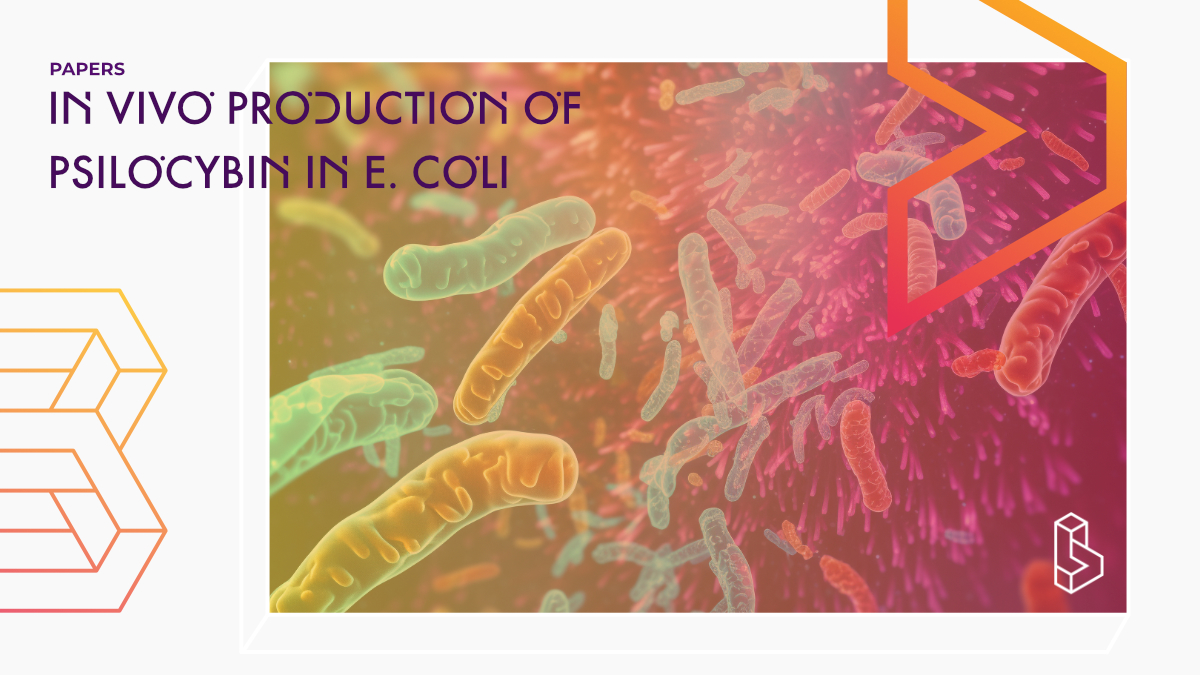This synthesis article (2019) explains the gram-scale production of psilocybin in E. coli (a prokaryotic host), which is a 32-fold improvement over earlier techniques. However, it’s still much more expensive than growing it in mushrooms/truffles.
Abstract of In vivo production of psilocybin in E. coli
“Psilocybin, the prodrug of the psychoactive molecule psilocin, has demonstrated promising results in clinical trials for the treatment of addiction, depression, and post-traumatic stress disorder. The development of a psilocybin production platform in a highly engineerable microbe could lead to rapid advances towards the bioproduction of psilocybin for use in ongoing clinical trials. Here, we present the development of a modular biosynthetic production platform in the model microbe, Escherichia coli. Efforts to optimize and improve pathway performance using multiple genetic optimization techniques were evaluated, resulting in a 32-fold improvement in psilocybin titer. Further enhancements to this genetically superior strain were achieved through fermentation optimization, ultimately resulting in a fed-batch fermentation study, with a production titer of 1.16 g/L of psilocybin. This is the highest psilocybin titer achieved to date from a recombinant organism and a significant step towards demonstrating the feasibility of industrial production of biologically-derived psilocybin. “
Authors: Alexandra M. Adams, Nicholas A. Kaplan, Zhangyue Wei, John D. Brinton, Chantal S. Monniera, Alexis L. Enacopol, Theresa A. Ramelot & J. Andrew Jones
Notes on In vivo production of psilocybin in E. coli
- First example of psilocybin production in prokaryotic host (E. coli)
- Genetic optimization shows high sensitivity to changes in transcriptional landscape
- Pathway bottlenecks removed through fine-tuned optimization
- Gram-scale production of psilocybin in Escherichia coli (E-coli)
“Despite significant improvements over early synthetic routes, current methods remain tedious and costly, involving numerous intermediate separation and purification steps resulting in an overall yield of 49% from 4-hydroxyindole (Shirota et al., 2003), incurring an estimated cost of $2 USD per milligram for pharmaceutical-grade psilocybin (Fricke et al., 2019).”
The costs per serving (before any other costs) would then be $40-$50 at 20-30mg per 70kg. This is still higher than the current costs of commercially available magic mushrooms or truffles (at $/€10-15).
“We conclude our work with a fed-batch bioreactor scale-up study, which resulted in the production of ~1160 mg/L of psilocybin, the highest titer reported to date from a recombinant host.”
This is a 32-fold increase over other methods. Most of this was possible because the team used three different optimization strategies concurrently.
“Future efforts to enhance the strain background to enable de novo production of psilocybin, without the need for chemical supplementation, could enable a biologically synthesized psilocybin pharmaceutical product to compete with chemical synthesis strategies for applications in medicine, psychology, and neurobiology.”
Biological synthesis still needs some other compounds (next to glucose) to grow psilocybin. The chemical synthesis might still be a better/cheaper way to make psilocybin.
Summary of In vivo production of psilocybin in E. coli
The development of a modular biosynthetic production platform in the model microbe, Escherichia coli, has resulted in the highest psilocybin titer achieved to date from a recombinant organism and a significant step towards demonstrating the feasibility of industrial production of biologically-derived psilocybin.
Psilocybin has gained attention in pharmaceutical markets as a result of recent clinical studies. It has been demonstrated to be effective for the treatment of anxiety in terminal cancer patients and alleviating the symptoms of post-traumatic stress disorder. Psilocybin was first purified from the Psilocybe mexicana mushroom by Albert Hofmann in 1958. It was not until the early 2000’s that large-scale synthesis methods were developed, involving numerous intermediate separation and purification steps. Scientists are interested in psilocybin because of its biosynthetic precursors, norbaeocystin and baeocystin, which have structural similarity to the neurotransmitter serotonin.
Find this paper
In vivo production of psilocybin in E. coli
https://doi.org/10.1016/j.ymben.2019.09.009
Open Access | Google Scholar | Backup | 🕊
Cite this paper (APA)
Adams, A. M., Kaplan, N. A., Wei, Z., Brinton, J. D., Monnier, C. S., Enacopol, A. L., ... & Jones, J. A. (2019). In vivo production of psilocybin in E. coli. Metabolic engineering, 56, 111-119.

